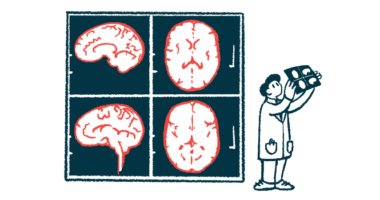Supercomputer Simulations Shed Light on Dopamine Release

Proteins involved in nerve cell communication — via the release of signaling molecules such as dopamine, which is abnormally low in people with Parkinson’s disease — are “spring-loaded” in advance of a triggering signal by calcium, supercomputer simulations showed.
These findings, which were consistent with current experimental data, may help explain the rapid release of signaling molecules such as dopamine, the researchers noted.
The study, “All-atom molecular dynamics simulations of Synaptotagmin-SNARE-complexin complexes bridging a vesicle and a flat lipid bilayer,” was published in Structural Biology and Molecular Biophysics.
Parkinson’s is caused by the loss of dopaminergic neurons, which are nerve cells that communicate with others by releasing the signaling molecule, or neurotransmitter, called dopamine.
Neurotransmitter release takes place at synapses, which are small gaps between neurons known as synaptic clefts. Before this release, neurotransmitters such as dopamine are contained in small membrane-bound compartments called vesicles.
When an electrical signal reaches the synapse, the influx of calcium ions triggers the rapid fusion of the vesicle membrane to the synapse membrane, releasing the neurotransmitter into the synaptic cleft. The neurotransmitters then bind to receptors on the adjacent neuron. In this way, electrical signals between neurons are propagated.
“The brain is an amazing network of communications,” lead author Jose Rizo-Rey, PhD, professor of biophysics at the University of Texas Southwestern Medical Center, said in a university press release. “When a cell gets excited by electrical signals, very fast synaptic vesicle fusion occurs. The neurotransmitters come out of the cell and bind to receptors on the synaptic side.”
“That’s the signal and this process is very fast,” Rizo-Rey said.
The structure and function of the proteins involved in neurotransmitter release are known. However, the steps leading to membrane fusion are unclear, partly because of the challenges involved in experimentally capturing such rapid events — occurring at less than 60 microseconds or millionths of a second.
Rizo-Rey and his team used the Frontera supercomputer at the Texas Advanced Computing Center (TACC), one of the most powerful computer systems in the world. Using a technique known as molecular dynamics, they built a multimillion atom model of the associated proteins, membranes, and their environment. This allowed them to move virtually to shed light on neurotransmitter release.
“Supercomputers weren’t powerful enough to resolve this problem of how transmission was occurring in the brain. So for a long time, I used other methods,” Rizo-Rey said. “However, with Frontera, I can model 6 million atoms and really get a picture of what’s going on with this system.
“What I did on Frontera, instead of a few months, would have taken 10 years,” he said.
The model included the SNARE complex, a group of proteins that assembles in such a way as to bring the vesicle membrane and plasma membrane together, like a zipper.
Synaptotagmin-1 (Syt1) is a protein that acts as a sensor that triggers fast neurotransmitter release in the presence of calcium ions with a group of proteins called complexins. Among these, complexin-1 binds tightly to the SNARE complex and is thought to play a stimulatory role by promoting the formation of a primed state.
The team ran four main simulations involving 1.7 to 5.9 million atoms — first with four SNARE complexes alone and two flat membranes, then four SNARE complexes with a spherical membrane, as seen in a vesicle, and a flat membrane.
Adding primed complexes containing Syt1, the SNARE complex, and complexin-1 showed the molecules resembled those seen in the primed state of synaptic vesicles. Lastly, the team tested all of these proteins plus membranes in the presence of calcium ions.
The simulations suggested SNARE complexes alone were able to induce the formation of extended membrane contact interfaces but may fuse too slowly.
With all the proteins together, the results showed that the binding of Syt1 and complexin-1 to SNARE complexes in primed vesicles leads to a “spring-loaded” arrangement of molecules that prevented premature membrane fusion but kept the system ready for fast action triggered by calcium.
“It’s ready to release, but it doesn’t,” Rizo-Rey explained. “Why doesn’t it? It’s waiting for the calcium signal. Neurotransmission is about controlling fusion. You want to have the system ready to fuse, so when calcium comes in, it can happen very fast, but it’s not fusing yet.”
The researchers noted that the results need to be interpreted with caution “because of the limited simulation times, the dependence of the results on the initial configurations and the absence of key elements of the release machinery.”
“Nevertheless, multiple features observed in the simulations make sense from structural and energetic points of view, and are consistent with abundant experimental data available on this system,” they said.
These simulations occurred over a few microseconds, which matches the fusion process, Rizo-Ray said. Still, he wants to see the rapid action of the spring-loaded proteins followed by the step-by-step fusion and transmission process. “If I see how it’s starting, the lipids starting to mix, then I’ll ask for 5 million hours [the maximum time available] on Frontera.”







